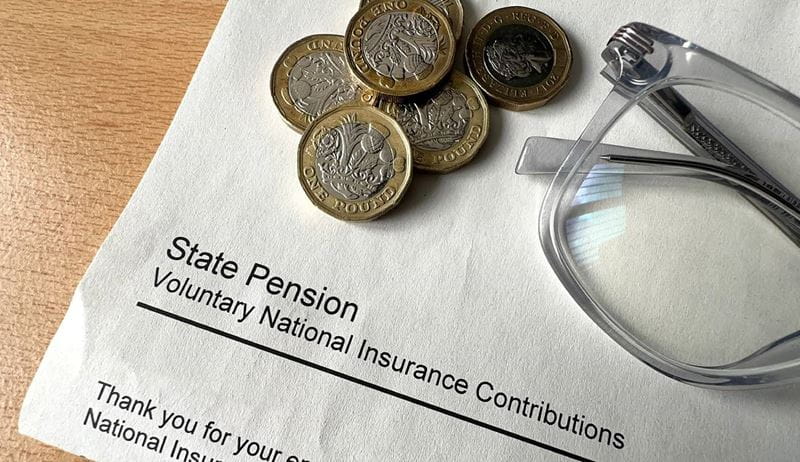

This article is for general guidance only and is not financial or professional advice. Any links are for your own information, and do not constitute any form of recommendation by Saga. You should not solely rely on this information to make any decisions, and consider seeking independent professional advice. All figures and information in this article are correct at the time of publishing, but laws, entitlements, tax treatments and allowances may change in the future.
For many of us, the state pension is an important part of retirement planning. But you’ll only get the full pension if you have paid enough national insurance contributions (NICs).
If your contribution record falls short, you might be able to plug the gap and boost your state pension by purchasing extra NICs. Here’s how to find out where you stand and the steps you can take if you’re facing a state pension shortfall.
What’s on this page?
The amount of state pension you get is related to the number of years you have paid national insurance (NI). You might hear this referred to as ‘qualifying years’.
When the new state pension was introduced back in 2016, the number of qualifying years for a full state pension increased from 30 to 35.
This means that you will only get the full state pension if you have 35 years of contributions. If you have between 10 and 35 years, you’ll only get a proportional payment. Or if you have less than 10 you won’t be entitled to a state pension at all.
The easiest way to find out if you have gaps is to check your NI record. Then check your state pension forecast. If you haven't retired yet, this will show you how much pension you are due currently, and how much more you could get if you work (or contribute) between now and state pension age. If you're already retired, you'll need to contact the Pension Service on 0800 731 0469 (0800 587 0892 in Northern Ireland) to ask if you could benefit from making backdated contributions.
There are lots of reasons why you might have gaps in your NI record, including:
If you were born before April 1951 (if you’re a man) or 1953 (if you’re a woman) you’ll likely have been claiming the old state pension for years by now, and will no longer be able to fill in gaps in your record.

You can currently buy voluntary contributions going back over the past six tax years and the deadline for each year is 5 April. It was previously possible to make contributions going back to 2006/7, to help people manage changes to qualifying years introduced in April 2016, but this opportunity has now closed.
Steve Webb, partner at pension consultancy LCP and former pensions minister, says that for most people with gaps in their record, paying voluntary national insurance contributions “represents excellent value” with the initial outlay paying for itself in just three or four years of higher state pension payments.
“The current cost of voluntary Class 3 contributions is £17.75 per week, or £923 for a year which would otherwise have been totally blank. Those who qualify to pay at the lower Class 2 rate for the self-employed pay even less than this,” he says.
In return for a year of voluntary contributions, someone who would otherwise have been short of the full rate can get an extra 1/35 of the full pension, he points out. This year, that works out at an extra £6.58 a week or £342 a year.
“This means that receiving an enhanced state pension for just three years – or four years allowing for income tax – will leave the contributor in profit, and every additional year they draw a pension after this point will be pure profit,” Webb says.
There are some cases when it’s not worth making voluntary contributions. If you have serious health issues that will affect your life expectancy, you need to consider whether you’re likely to live long enough for your contributions to be repaid in a higher pension.
If you’re on means-tested benefits such as pension credit, a higher pension may result in lower benefits, sometimes on a pound-for-pound basis.
Tom Selby, director of public policy at wealth firm AJ Bell, says if you’ve had work gaps or have spent time abroad not paying NI, voluntary contributions can be a sensible investment. But, he adds, before making any decision, “it is crucial to check this is the right option, as not everyone will benefit from paying voluntary NI.”
“For example, if you are relatively young and working, you will likely build up the 35 years of NI contributions you need to get the full state pension naturally. Equally, those who have taken time out of work to care for children or elderly relatives may be able to claim NI credits for free,” Selby says.
claim NI credits to fill gaps when you weren’t paying NI. Check if you’re entitled to ‘free’ NI credits before you pay voluntary NI contributions.
These credits are available in a wide range of circumstances – as explained on the government website. Some credits are awarded automatically, such as for recipients of child benefit or carers allowance.
But some have to be claimed, such as ‘grandparent’s credits’ (properly known as Specified Adult Childcare credits). Or you can claim for ‘carer’s credits’ if you’ve been doing more than 20 hours a week of looking after a disabled person but not getting Carer’s Allowance.
The government has made it easier for people to check for and then pay for any gaps in their national insurance record.
In many cases, you can do it all online. It doesn’t take long to do, though it might take a little longer if you don’t already have an online account with HMRC.
If you’re under state pension age, the Check your state pension forecast service will show you how much your state pension could increase by, and details of the voluntary NI contributions you would need to pay to achieve this.
You can also use the service to view gaps in your NI record and pay voluntary contributions to fill those gaps, if that will mean you’re better off. You can choose which years you want to pay to fill, and pay securely online.
You should receive confirmation that your payment has been received and that your NI record will be updated. To access the state pension forecast service, you need to log in to the digital service using your HMRC personal tax account login details. If you don’t have an online HMRC account, you can register for an account.
Webb says: “Using the personal tax account service should mean that you don’t have to wait in a queue for a call handler and you have documentary evidence of the payment.”
The service is not currently available to those who are already receiving their state pension, who are self-employed, or currently living outside the UK with gaps incurred while abroad. (If you’re living abroad and want to pay voluntary contributions for years you were resident in the UK, you can use the online service.)
If you’re not able to access the online service, you'll need to contact the Pension Service on 0800 731 0469 (0800 587 0892 in Northern Ireland) to establish which years are gaps, how much they would cost to fill and which one(s) to fill. You’ll then need to call HMRC on 0300 200 3500 to get a code to make sure that any payment is allocated to the correct account.
Webb says that unfortunately it can take months for NI contributions to be added to your record and then there is likely to be a further wait for the Department of Work and Pensions to reassess your entitlement to the state pension. So it’s a good idea to allow yourself plenty of time to complete the process.


Learn how to identify and change your attitude to money

Expert guidance on warranties, payments, and pre-purchase checks..

How to make up to £175 in cash with bank switch offers - and the switching process is easier than you might think.

From energy to food to transport, we reveal what's expected to happen to prices over the coming year.

From filing your tax return to returning unwanted gifts, find out how to get 2025 started on the right track.